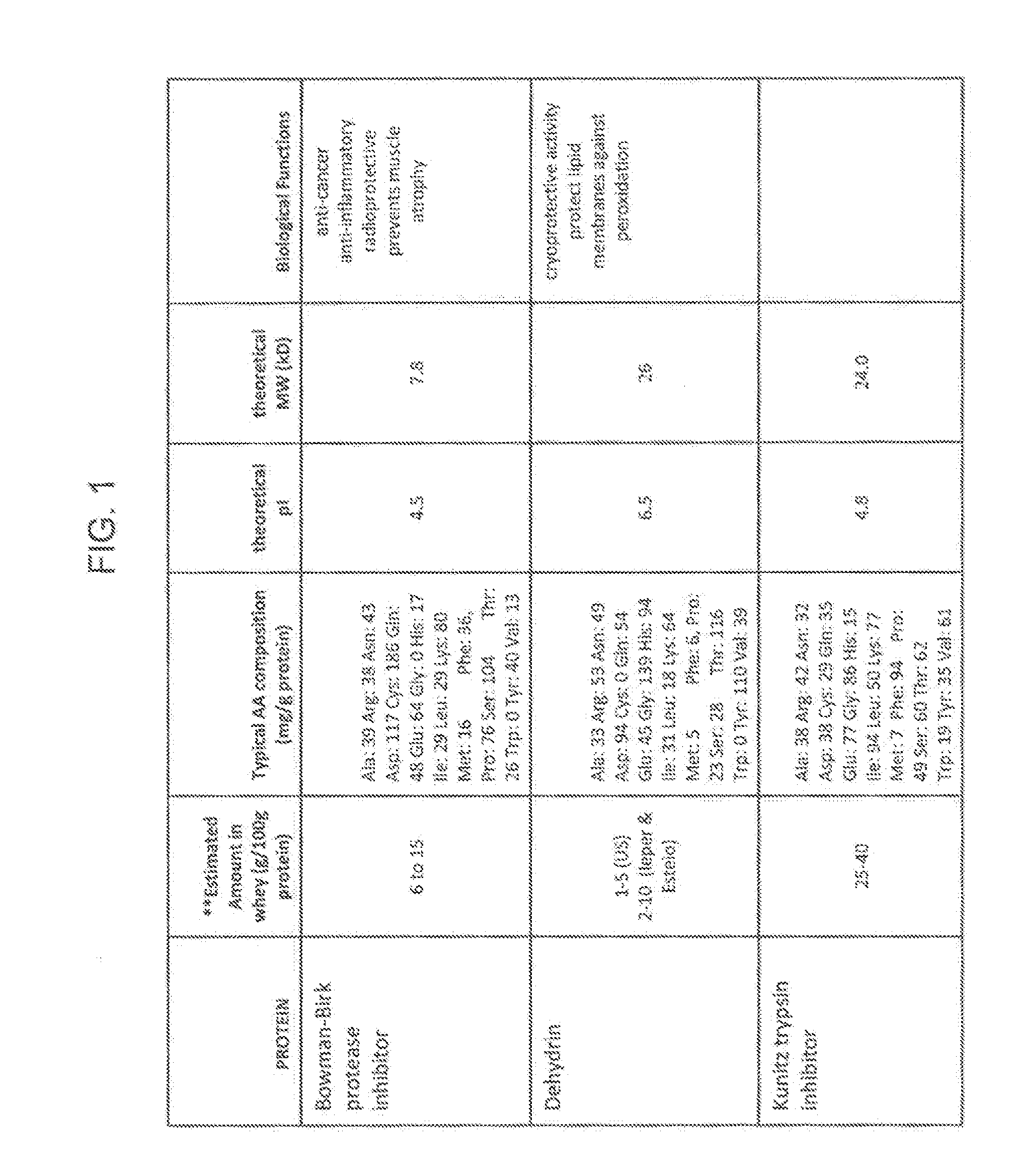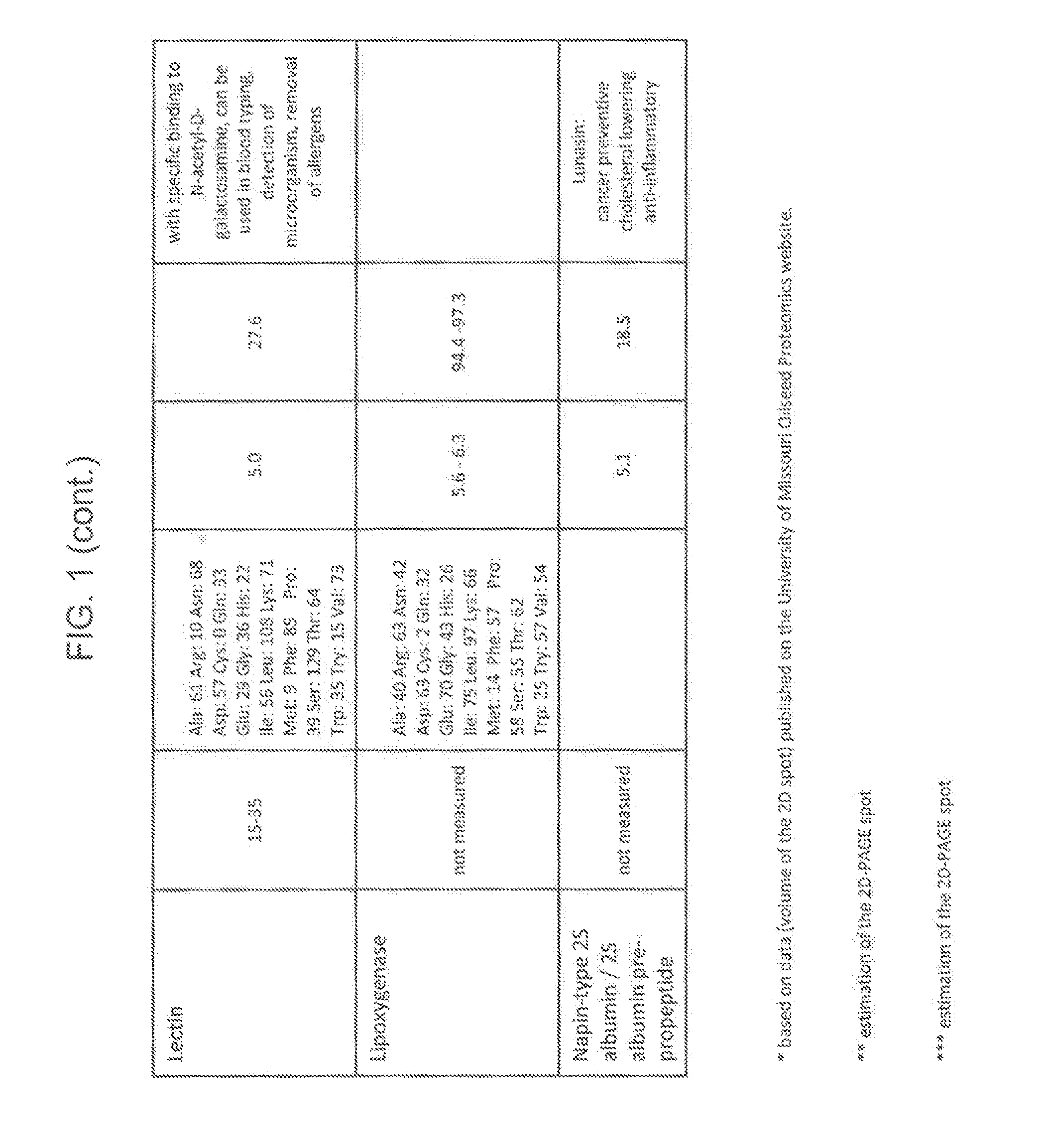Baked food compositions comprising soy whey proteins that have been isolated from processing streams
- Summary
- Abstract
- Description
- Claims
- Application Information
AI Technical Summary
Benefits of technology
Problems solved by technology
Method used
Image
Examples
example 1
Recovery and Fractionation of Soy Whey Protein from Aqueous Soy Whey Using Novel Membrane Process
[0246]145 liters of aqueous raw soy whey (not pre-treated) with a total solids content of 3.7% and dry basis protein content of 19.8% was microfiltered using two different membranes in an OPTISEP® 7000 module, manufactured by SmartFlow Technologies. The first membrane, BTS-25, was a polysulfone construction with 0.5 um pore size manufactured by Pall. Aqueous soy whey was concentrated to a 1.6× factor, at an average flux of 30 liters / meter2 / hr (LMH). The concentrated aqueous soy whey was then passed through a modified polysulfone microfiltration membrane, MPS 0.45, manufactured by Pall. The aqueous soy whey was concentrated from 1.6× to 11× at an average flux of 28 LMH.
[0247]Permeate from the microfiltration process, 132 liters total, was then introduced into an OPTISEP® 7000 module with ultrafiltration membranes, RC100, which are 100 kDa regenerated cellulose membranes manufactured by Mi...
example 2
Recovery and Fractionation of Soy Whey Protein from Soy Molasses Using Novel Membrane Process
[0250]61.7 liters of soy molasses with a total solids content of 62.7% and dry basis protein content of 18.5% was diluted with 61.7 liters of water prior to microfiltration. The diluted soy molasses was then microfiltered using an OPTISEP® 7000 module, manufactured by SmartFlow Technologies. The diluted soy molasses passed through a modified polysulfone microfiltration membrane, MPS 0.45, manufactured by Pall. The diluted soy molasses was concentrated to a 1.3× factor, at an average flux of 6 liters / meter2 / hr (LMH).
[0251]Permeate from the microfiltration process, 25 liters total, was then introduced into an OPTISEP® 7000 module with ultrafiltration membranes, RC100, which are 100 kDa regenerated cellulose membranes manufactured by Microdyn-Nadir. The microfiltered diluted soy molasses was diafiltered with 2 volumes of water prior to being concentrated to 7.6× at an average flux of 20 LMH, re...
example 3
Capture of Bulk Soy Whey Protein from Defatted Soy Flour Extract
[0254]Defatted soy flour (DSF) was extracted by adding a 15:1 ratio of water to DSF at a pH of 7.8 and stirring for 20 minutes prior to filtration. The extract was microfiltered using an OPTISEP® 800 module, manufactured by SmartFlow Technologies. The microfiltration membrane, MMM-0.8, was a polysulfone and polyvinylpropylene construction with 0.8 um pore size manufactured by Pall. Aqueous soy extract was concentrated to a 2.0× factor, at an average flux of 29 liters / meter2 / hr (LMH). Permeate from the microfiltration process was then introduced into an OPTISEP® 800 module with ultrafiltration membranes, RC100, which are 100 kDa regenerated cellulose membranes manufactured by Microdyn-Nadir. The microfiltered aqueous soy extract was concentrated to about 6.3× at an average flux rate of 50 LMH. The final retentate measured 84.7% dry basis protein content.
PUM
 Login to View More
Login to View More Abstract
Description
Claims
Application Information
 Login to View More
Login to View More - R&D
- Intellectual Property
- Life Sciences
- Materials
- Tech Scout
- Unparalleled Data Quality
- Higher Quality Content
- 60% Fewer Hallucinations
Browse by: Latest US Patents, China's latest patents, Technical Efficacy Thesaurus, Application Domain, Technology Topic, Popular Technical Reports.
© 2025 PatSnap. All rights reserved.Legal|Privacy policy|Modern Slavery Act Transparency Statement|Sitemap|About US| Contact US: help@patsnap.com



